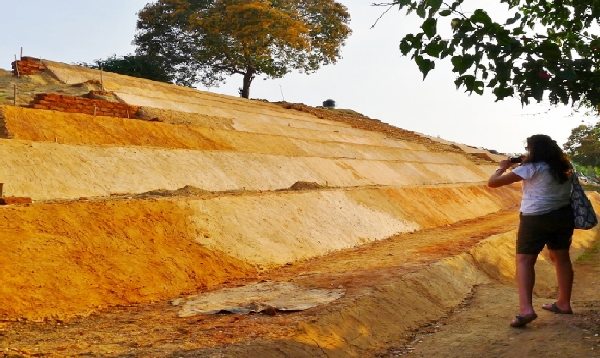Xihuacan, Mexico - About a half-hour drive from western Mexico's mega-resort at Ixtapa, there's a tiny village out in the boonies that's soon going to be seeing a lot of tourists. The big attraction there - set to open to the public in early 2013 - is an immense, 3,000 year old archeological site being excavated just outside the village.
The site is called Xihuacan (she-wha-cahn), meaning "place of the people who control eternity." Archaeologists working on the project say it was a sort of multi-cultural ceremonial center, having been used for the worship of different gods by pre-Columbian tribes such as the Cuitlatecas, Tarascans, Mixtecas, Aztecs, Zapotecas, Totonacas, and as far back as the Toltecs and Olmecs. "We've even found evidence that Mayans once gathered here, far from their lands in the east," said site archaeologist Rodolfo Lobato.
Boosting the clout of prayers to the gods for rain, fertility, bountiful crops and the like were human sacrifices, typically twice every three months.
 |
| Travel agents get a preview of Xihuacan's ball court. |
Xihuacan is believed to stretch out over an area of eight square miles, of which only a small section has been excavated since work began on the site a few years ago. Among major structures restored so far is a square, 45 foot high pyramid about the length of a football field on each side. Another eye-popping marvel is a 180 foot long ball court, believed to be the second largest in Mexico after the Mayan court at Chichen Itza on the Yucatan Peninsula.
Next up for excavation are the ruins of what's believed to be a royal palace next to the ball court. The palace, like many other structures on the site, is buried under tons of sand, possibly the result of a huge tsunami wave that came rolling in from the Pacific many centuries ago.
Greeting visitors to Xihuacan is a museum displaying figurines, vases, copper axes, carved sea shells, ceramics, bell necklaces, and other artifacts from different cultures. A relief map of the small portion of the site excavated so far shows the locations of a half-dozen temples where various tribes gathered for ceremonies over the centuries.
"Xihuacan could very well have been Mexico's first convention center," quips Ana Luisa Moran, spokeswoman for the Ixtapa-Zihuatanejo ("I-Z") Convention & Visitors Office. Local tourism officials, she notes, are gearing up for promotional programs to be aimed at vacationers staying in the I-Z hotels as well as future cruise passengers during stops at the Zihuatanejo harbor.
Located 150 miles up the coast from Acapulco, the Ixtapa resort is billed as a dual vacation destination with the neighboring village of Zihuatanejo and its gorgeous, mushroom-shaped bay. "I think the archaeological site will be a fabulous new attraction for us," says Eva Beer, owner of the Catalina Beach Resort on the bay.
Together, Ixtapa and Zihuatanejo offer a total of 6,000 hotel rooms plus condos. Ixtapa will shortly increase its inventory by 323 luxury suites when the new Azul Ixtapa Grand debuts in early 2013. The property includes an existing convention center capable of hosting 2,400 delegates and the earlier opened 412-room Azul Ixtapa.
Back at Xihuacan, with more and more trucks and buses zipping by the villagers' 80 or so houses to get there, local businesspersons are said to be looking forward to a economic windfall next year. One bonanza might be in T-shirt sales, some perhaps reading "I (heart) Xihuacan."


